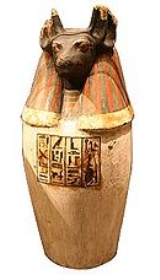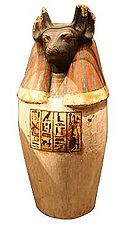
Duamutef
Encyclopedia

Four sons of Horus
The four sons of Horus were a group of four gods in Egyptian religion, who were essentially the personifications of the four canopic jars, which accompanied mummified bodies. Since the heart was thought to embody the soul, it was left inside the body. The brain was thought only to be the origin of...
and a protection
god of the Canopic jar
Canopic jar
Canopic jars were used by the Ancient Egyptians during the mummification process to store and preserve the viscera of their owner for the afterlife. They were commonly either carved from limestone or were made of pottery...
s. Commonly he is said to be the son of the god Horus the Elder
(Heru-ur) and the goddess Isis
Isis
Isis or in original more likely Aset is a goddess in Ancient Egyptian religious beliefs, whose worship spread throughout the Greco-Roman world. She was worshipped as the ideal mother and wife as well as the matron of nature and magic...
. There is another myth that describes
Duamutef and his brothers as sons of Osiris. According to this myth they
were born from a lotus blossom that arose from the primeval ocean.
The name Duamutef means "Who adores his mother".
Portrayal
First Duamutef was displayed as human wrapped in mummy bandages.Since the New Kingdom
New Kingdom
The New Kingdom of Egypt, also referred to as the Egyptian Empire is the period in ancient Egyptian history between the 16th century BC and the 11th century BC, covering the Eighteenth, Nineteenth, and Twentieth Dynasties of Egypt....
he is shown with the head of a jackal
Jackal
Although the word jackal has been historically used to refer to many small- to medium-sized species of the wolf genus of mammals, Canis, today it most properly and commonly refers to three species: the black-backed jackal and the side-striped jackal of sub-Saharan Africa, and the golden jackal of...
.
In some cases his appearance is swapped with Qebehsenuef's so
he has the head of a falcon and Qebehsenuef has the head of a jackal.
Duamutef usually was shown on Sarcophagus
Sarcophagus
A sarcophagus is a funeral receptacle for a corpse, most commonly carved or cut from stone. The word "sarcophagus" comes from the Greek σαρξ sarx meaning "flesh", and φαγειν phagein meaning "to eat", hence sarkophagus means "flesh-eating"; from the phrase lithos sarkophagos...
and as cap of
canopic jars. Some images of the Judgement of heart show him staying
together with his brothers in front of Osiris on a small lotus blossom.
Meaning as Protection God of Canopic Jars
Together with the three other sons of Horus Imsety, HapiHapi
Hapi, sometimes transliterated as Hapy, is one of the Four sons of Horus in ancient Egyptian religion, depicted in funerary literature as protecting the throne of Osiris in the Underworld. He is not to be confused with another god of the same name...
and
Qebehsenuef
Qebehsenuef
Qebehsenuef was one of the sons of Horus in Egyptian mythology, the god of protection and of the West. In the preparation of mummies, his canopic jar was used for the intestines. He is seen as a mummy with a falcon head...
he protected the mummified internal organs.
His duty was to protect the stomach. His protector is the goddess Neith.
See also
- Four Sons of HorusFour sons of HorusThe four sons of Horus were a group of four gods in Egyptian religion, who were essentially the personifications of the four canopic jars, which accompanied mummified bodies. Since the heart was thought to embody the soul, it was left inside the body. The brain was thought only to be the origin of...
– in-depth treatment of the Four Sons and their interrelationships.

